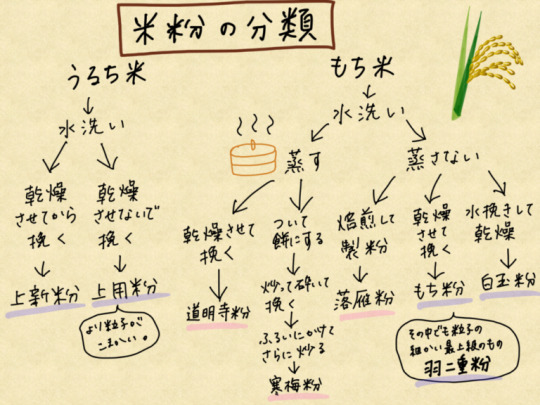#cook:米粉
Explore tagged Tumblr posts
Photo

✿ 米粉と山芋で超モッチリ!お好み焼き ✍️ 米粉50〜100g,桜えび,ソース→中濃ソース大1と1/2+ケチャップ大1/2+オイスターソース小1+砂糖小1/2
#cook:米粉#cook:桜えび#cook:お好み焼き#cook:米粉と山芋で超モッチリ!お好み焼き#cook#cook:2025〜#cook:主食:米粉#cook:お好み焼き:米粉#cook:米粉:お好み焼き#cook:やまいも#cook:ながいも#cook:オイスターソース×ケチャップ×砂糖×中濃ソース#cook:主食#cook:キャベツ#cook:マヨネーズ#cook:オイスターソース×ケチャップ×砂糖×中濃ソース×マヨネーズ#cook:かつお節#2025〜#cook:主食:2025〜
0 notes
Text
For this homestyle Fried Bee Hoon (炒米粉) or rice vermicelli, mum prepped omelette, added the leftover boiled pork belly with scallops, tiger prawns and bean sprouts since only the two of us are eating.

#Mum's Cooking#Home-Cooked#Fried Bee Hoon#炒米粉#Rice Vermicelli#Omelette#Egg#Pork Belly#Scallop#Tiger Prawn#Prawn#Seafood#Dinner#Asian Food#Food#Buffetlicious
134 notes
·
View notes
Text
Breakfast foods in China
Since arriving in China my typical breakfast has changed quite a lot (hello baozi and mung bean paste!) so I decided to explore some common local breakfast foods eaten in China!
包子 - Bāozi (my love) These have been an almost consistent (excluding the lunar new year when the canteens and most cafes and restaurants closed) staple of my breakfast ever since I arrived in China. They come with several fillings such as veggie, pork, seafood etc. and they can cooked in different ways such as being steamed, fried etc. Here's a more in-depth post about the types of dumplings and bāo.
粥 - Porridge (zhōu) I sometimes have porridge for lunch instead and it's a really filling meal. I get the Century Egg Congee with Chicken - 皮蛋瘦肉粥 (Pídàn shòu ròu zhōu) and it's one of my all time favourite meals.
煎饼 - Egg pancake (jiānbing) Popular also as a street food, this is a thin crepe type pancake with an egg, veggie, spice, sauce and sometimes meat filling. The actual filling varies as you can customize what veggies and spice level you'd like and whether or not you want meat.
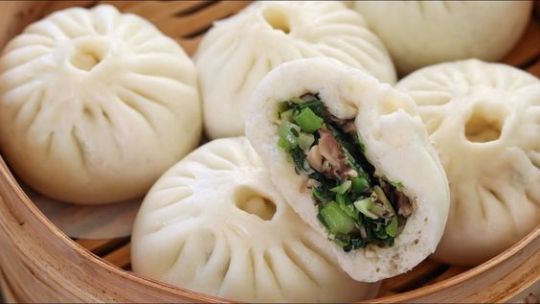
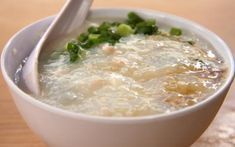

热干面 - Hot and dry noodles (règānmiàn) I honestly had no idea about this dishes existence until a while ago, probably because it's a regional dish originating from Wuhan which is kind of far away from my location. These are spicy and dried noodles which are actually eaten without a broth unlike many other noodles. They seem pretty interesting so if anyone tried them before do share your experience!
桂林米粉 - Guilin Rice noodles (guìlín mĭfĕn) This appears to be another regional dish from Guilin, Guanxi as I had no idea that this was a also a pretty popular breakfast dish. Apparently it's not the noodles but rather the broth that they're cooked in that makes them special, with the actual recepie varying across the region. Someone should do a long weekend trip vlog (pondering on this) to Guilin where they just go from store to store trying these noodles and trying to determine the differences.
葱油饼 - Scallion oil pancake (cōngyŏubĭng) A tasty but heavy-ish pancake imo. These pancakes are cooked with scallions (green onion) and pan-fried to give it that crispy and chewy texture. Very tasty, but it's a little too heavy on the oil for me so I save these pancakes for special occasions instead.

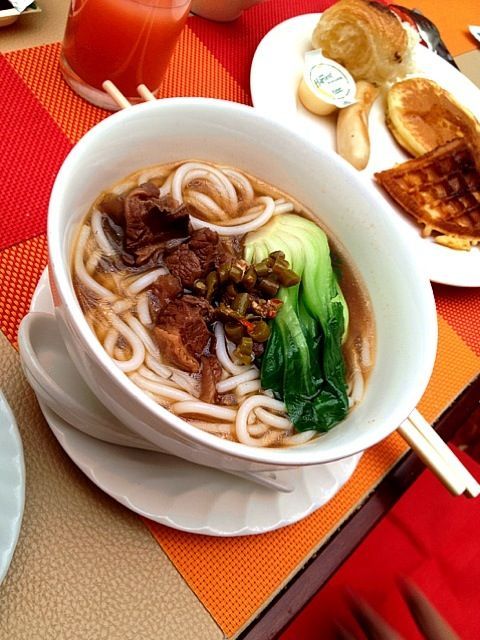
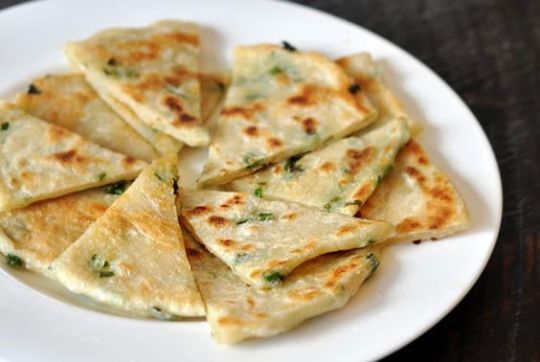
豆浆油条 - Soy milk and deep-fried dough sticks (dòujiāng yóutiáo) I have tried the dough sticks, and I have tried soya milk but separately so far. The dough sticks are these long deep-friend dough sticks, reminding me slightly of breadsticks but more lighter and chewier.
茶鸡蛋 - Tea eggs (chájīdàn) I adore these, my canteen serves them along with regular eggs for breakfast and the tea eggs are usually the first to go. They actually don't really involve tea, instead these eggs are cooked in a mixture of chinese five-spice powder (pepper, cloves, cinnamon, star anise and fennel seeds), soy sauce, and black tea leaves, although some recipes leave out the tea leaves. They have a relatively strong smell so I usually grab some for breakfast on the weekends or in the canteen at lunch if there are any leftover after breakfast. They are also quite cheap, one egg is around 2 yuan so around 0.30 euro, making them a pretty filling and affordable breakfast food.
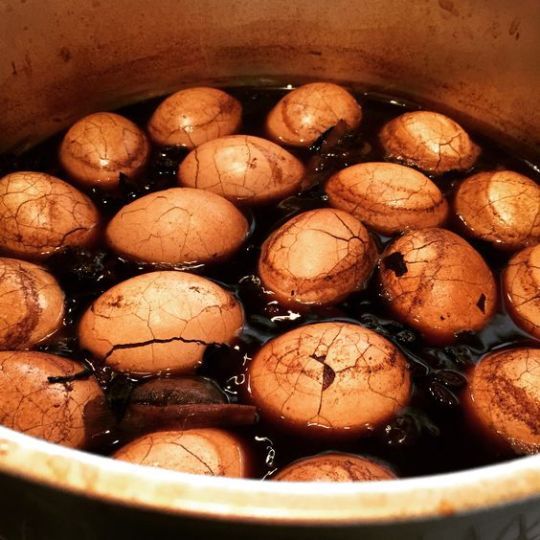
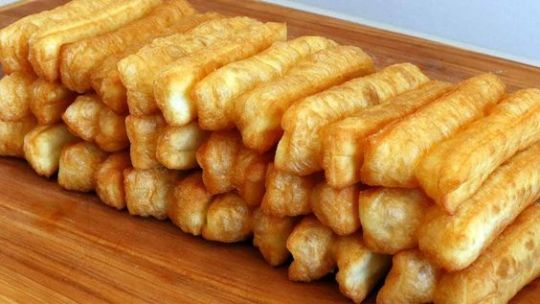
If there are any other common or specific breakfast foods that you know of, do share them please as I love trying out new things!
#chinese food#studyblr#college life#student life#study blog#life in china#aesthetic#student#study motivation#travel blog#china#study in china#college#slavic roots western mind#asia#chinese#asian food#baozi#cuisine#food#foodpics#dumplings#breakfast food#breakfast food in china#pancakes#tea eggs#porridge#congee#noodles#this is slowly turning into a food blod and im okay with it
102 notes
·
View notes
Text
The Todorokis and food - Part 5: Karē rice (カレーライス) and Nikujaga (肉じゃが)
While working to a better, single version of my Todoroki mansion posts, I was tempted to add to it the foods we also know the Todorokis eat or the ones we see prepared in the house.
In hindsight though, it felt silly as foods aren’t really neither architectonicals elements or furniture so I decided to make a separate post for them. As I work on the comprehensive version I decided to split the demo version in small parts so that people could enjoy it as it gets worked over.
This bit deals with what Shōto and his classmates cooked during the forest training camp.
WHAT SHŌTO HELPS COOKING AT THE FOREST TRAINING CAMP
At their arrival at the forest training camp, class A and B found a dinner cooked by the Pussycats, which was described as including, ‘sakana mo niku mo yasai mo’ (魚も肉も野菜も “fish, meat and vegetables”) but no name for the dishes prepared is given. I might try to track down what was served but for now I'll focus on how, on the following day, the two classes had to cook their own meal, and they were told to prepare ‘karē’ (カレー “curry”), meaning ‘karē rice’ (カレーライス “curry rice”), while, on the next day, they prepare ‘nikujaga’ (肉じゃが “beef and potato”). We saw Shōto helping in both occasions and, of course, he should have eaten both dishes.


KARĒ (カレー “curry”): a dish originating from India in which ingredients are simmered with ‘Karē-ko’ (カレー粉 “curry powder”), a spice mix. There are various versions of it, Indian curry, Thai curry, European-style curry… because even though it is generally considered to be a spicy dish, in fact it has a wide variety of flavors because the combination of ingredients and spices varies depending on the region, religion, and household. In Japan it’s made with ‘Komugiko’ (小麦粉 “wheat flour”) to thicken it and whose the balance of sweetness and spiciness is adjusted, resulting in a flavor that is different from curry in other countries while the meat used is usually either beef (in west Japan), pork (in east Japan), or chicken while the basic vegetables are ‘jagaimo’ (じゃがいも/ジャガイモ “potatoes”), ‘ninjin’ (にんじん/ニンジン “carrots”), and ‘tamanegi’ (たまねぎ/タマネギ “onions”).

Komugiko (小麦粉 “wheat flour”): wheat flour made by milling wheat and is used as an ingredient in various foods which in Japan is also called ‘udonko’ (うどん粉 “udon flour”) or ‘MERIKEN ko’ (メリケン粉 “American flour”).

Karē-ko (カレー粉 “curry powder”): a mix of spices used to make curry dishes, made combining dozens of ingredients, including ‘ukon’ (ウコン “turmeric”) and ‘tōgarashi’ (トウガラシ“chili peppers”. In Japan people usually don’t make it but buy it in bottles or cans.

KARĒ RICE (カレーライス “curry rice”): it’s a dish in which curry is served over or next to ‘gohan’ (ご飯 “cooked rice”) and it’s so popular in Japan it’s considered a national dish and simply called ‘karē’ (カレー “curry”). It’s usually eaten with a ‘chirirenge’ (散蓮華), the Japanese spoon.

Gohan (ご飯 “cooked rice”): it is a food made by adding water to grains of the grass family, especially ‘kome’ (米 “rice”), and boiling or steaming it. When one wants to make sure to point out it’s specifically rice they can call it ‘beihan’ (米飯).

Chirirenge (散蓮華 “petal of a lotus flower that has fallen off”) or renge (蓮華 “petal of a lotus flower”): Asian spoon usually made of ceramic whose shape is similar to a petal of lotus flower. It has almost the same usage of a regular western spoon but a quite different shape as its bottom is deep and flat and the handle has a little nook, and it is curved and thick. The one specially designed for ramen has a small dent so it can be hooked onto the rim of the ramen bowl without it slipping into the depths of your soup, while the one for miso ramen has with some holes in the bottom so as to make easier to pick up corn pieces. When holding it, one must fit their index finger on the ditch or the inner handle and hold it with their thumb and middle finger.

Nikujaga (肉じゃが “beef and potatoes”): a Japanese stew dish made by simmering meat (be it beef, pork, chicken or other types) and ‘jagaimo’ (じゃがいも/ジャガイモ “potatoes”) in a sweet and spicy sauce made with ‘shōyu’ (醤油 or 醬油 “soy sauce”) and sugar, and may also contain ‘ninjin’ (にんじん/ニンジン “carrots”), ‘tamanegi’ (たまねぎ/タマネギ “onions”) and ‘ito konnyaku’ (糸蒟蒻 “konnyaku noodles”). There are many different ways to prepare it, and there is no set cooking process. It can be broadly divided into two methods: stir-frying in oil and then simmering, and simmering without stir-frying. It’s commonly eaten with chopsticks.

Shōyu (醤油 or 醬油 “Soy sauce”): a liquid condiment of Chinese origin, traditionally made from a fermented paste of soybeans, roasted grain, brine, and Aspergillus oryzae or Aspergillus sojae molds. It is recognized for its saltiness and pronounced umami taste.

Ito konnyaku (糸蒟蒻 “konnyaku thread”): a Japanese food made with ‘konnyaku’ (蒟蒻) cut into noodle-like strips which is usually sold in plastic bags with accompanying water, which was drained before cooking.

Konnyaku (蒟蒻): a gelatin made mixing ‘konnyakuko’ (蒟蒻粉 “konjac flour”) with water and a coagulating agent and, according to the region, seaweed powder which will give it his grey color, otherwise it looks white.

Konnyaku-ko (蒟蒻粉 “konjac flour”): flour derived from the ‘Konnyaku (コンニャク “konjac”), a plant species native to Yunnan in southwestern China.

2 notes
·
View notes
Text
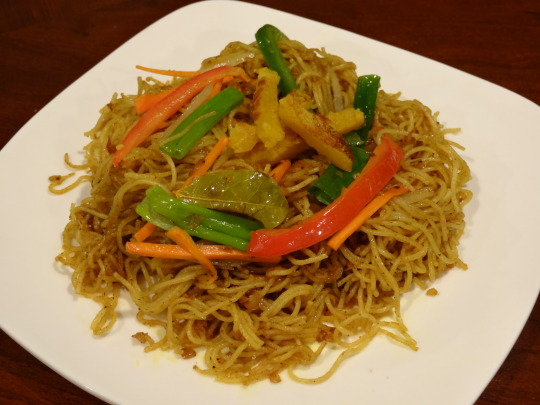
星洲炒米粉 / Xing zhou chao mei fun (Singapore noodles)
This dish fries steamed noodles and assorted vegetables in a mildly spicy curry paste, made from a bespoke curry powder and a blend of fresh aromatics. The result is a crispy, chewy, complex, warming stir-fry with notes of turmeric, liquorice root, and cinnamon.
Though this dish is referred to as "Singapore noodles," vermicelli dishes common in Singapore do not include curry powder! These "Singapore" noodles in fact originated in Hong Kong 茶餐廳 (cha chaan teng; Western-influenced cafés), and gained popularity between the 1940s and 60s. They combine British influence (in the form of curry powder) with the rice noodles common in Chinese, Malay, and Indian cooking; the reference to Singapore is perhaps a nod to the cosmopolitan, "exotic" atmosphere of these cafés.
This is a vegan version of a dish that often also includes shrimp, char siu, or chicken. Instructions for a vegan version of the typical sliced fried egg topping are included.
Recipe under the cut!
Patreon | Tip jar
Serves 3-4.
Ingredients:
For the dish:
200g vermicelli rice noodles (bee hoon / mi fen; 米粉)
4 green onions, greens and whites separated
1/2 medium yellow onion, thinly sliced
1 medium (50g) julienned red mild chili (such as aji dulce), or 1/4 medium red bell pepper
1 medium (50g) julienned green mild chili, or 1/4 medium green bell pepper
1 bunch yellow chives
Small handful bean sprouts
3-inch piece (40g) carrot, julienned
1 tsp table salt, or to taste
Large pinch MSG (optional)
Rice vermicelli (also known as bee hoon / bihun, mee hoon / mihun, or mi fen) are long, fine rice noodles. They should not be confused with semolina vermicelli. They may be purchased at an east or southeast Asian grocery store; Chinese, Vietnamese, or Thai rice vermicelli will all work. I used Hai Ca Vang rice vermicelli, which I like in this dish for how well they stand up to stir-frying, and the chewy bite they give to the final dish.
Yellow chives are simply chives that have less color because they are grown out of the sun. They may be found in a Chinese grocery store; if you can't get your hands on any, omit them or substitute more bean sprouts.
For the curry paste:
4 tsp curry powder Singapura, or to taste
3 cloves garlic
4 Thai shallots, or 1 Western shallot
1-inch chunk (10g) ginger
1/4 medium yellow onion
White of 1 stalk lemongrass (optional)
1 bay leaf (optional)
Some versions of Singapore noodles are flavored entirely with curry powder, or (if a spicier curry powder is being used) with a mix of curry powder and turmeric; home cooks tend to include less curry powder or paste than restaurants do. You could decrease the amount of curry powder down to about a teaspoon for a home cook version of this dish. If you aren't making your own, Singapore curry powder (咖哩粉) can be purchased online from specialty spice retailers, or from a Hong Kongese brand such as Koon Yick Wah Kee; you could also substitute another mild, sweet curry powder, such as Japanese curry powder (S&B is a popular brand).
You could skip prepping the aromatics as well by purchasing a jar of ready-made Chinese curry paste (咖哩醬) from a brand such as Koon Yick Wah Kee (whose blend consists of curry powder hydrated with white vinegar and soybean oil); Malaysian curry paste would be a good substitute. Some recipes make a quick homemade curry paste by combining curry powder with salt (1 tsp), sugar (1 tsp), oyster sauce (1 Tbsp), water (2 Tbsp), and sometimes chili sauce, and add this sauce to the noodles as they are fried. I prefer versions of the dish that add fresh aromatics, though—I think they round out the curry powder by providing a flavorful base for it. You can experiment until you get the flavor and texture you prefer.
For the egg:
1/4 cup (60mL) coconut milk, or water
1/2 tsp ground turmeric
1/4 - 1/3 tsp kala namak (black salt)
1/4 tsp ground white pepper (optional)
1/2 tsp Liaojiu (Chinese cooking wine)
Liaojiu will likely be labelled "Shaoxing wine" in English. For an alcohol-free version, use ume plum vinegar or apple cider vinegar. The wine is used to flavor and cut the 'egginess' of the eggs.
This recipe usually calls for eggs, liaojiu, and salt. The turmeric and white pepper add flavor and color; the kala namak provides an eggy taste.
Instructions:
1. Prepare the aromatics. Peel and chop the garlic; mince the onion and shallots; scrub and mince the ginger (there's no need to peel it). Divide the whites of the green onions from the greens, and mince the whites.
Pull away any tough outer leaves of lemongrass. Separate the yellow / white section from the green, and cut off the root end. Reserve the green to flavor soup stocks. Thinly slice the white of the lemongrass widthwise, then pass the knife through for another few minutes to mince very thoroughly.
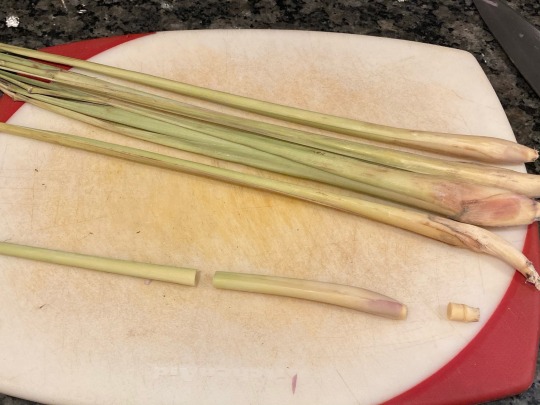
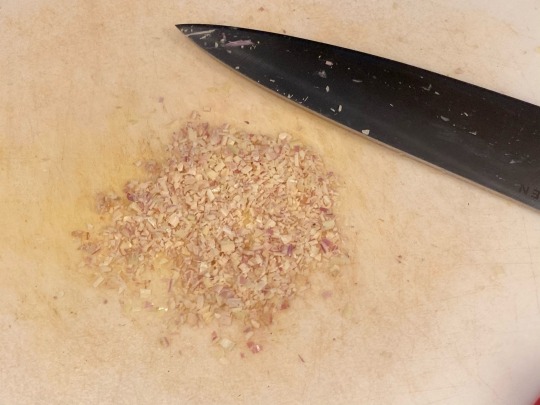
For a "saucier" noodle dish, pulverize the aromatics in a mortar and pestle or a blender rather than mincing them.
2. Prepare the vegetables. Cut peppers into a thin julienne; julienne the carrots; thinly slice the onion. Cut the greens of green onions, bean sprouts, and chives into 1 1/2 or 2” pieces.
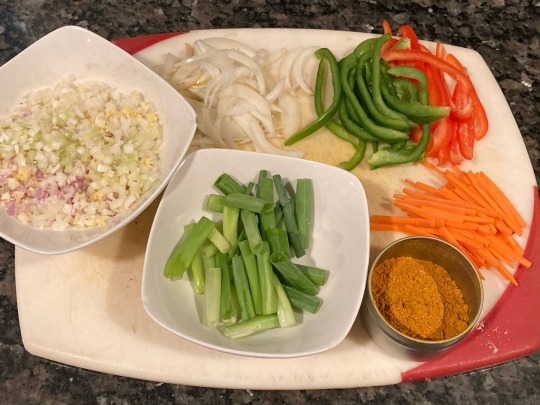
3. Cook the noodles. Soak noodles in just-boiled water for about 90 seconds, or until they break when pinched firmly. Depending on the thickness of your noodles, they may need as much as 2-3 minutes.
Drain the noodles, but don’t rinse them. Spread them out on a baking sheet and cover to allow to steam for 10 minutes. With oiled hands, gently pull apart and untangle the noodles. Cut them in a few places with kitchen scissors to make stir-frying easier.
4. Cook the egg garnish. Whisk all ingredients for the egg together in a small bowl. Heat a wok over medium heat for several minutes, then add in a couple teaspoons of oil and swirl to coat the surface of the wok. Pour ‘egg’ into the bottom of the wok, then lower heat to low and allow to cook until darkened and solidified on top. Flip and cook the other side on medium-high until browned in places. Remove from wok and thinly slice.
5. Cook the vegetables. Heat wok on high for several minutes. Add in a couple teaspoons of oil and swirl to coat. Fry sliced onions, agitating often, for about 30 seconds; add carrots and fry another 30 seconds. Add peppers and cook for another 20-30 seconds. Remove from wok.
Cook chives or bean sprouts for 30 seconds to a minute, until slightly wilted, and remove.
6. Make the curry paste. Add another couple teaspoons of oil to the wok. Fry the aromatics (whether minced or pulverized) and bay leaf, stirring often, until fragrant, about 2 minutes. Lower heat to low, then add the curry powder and stir. Immediately add another couple teaspoons of oil, or enough to create a bit of sauce (the amount will vary based on how much curry powder you've added).
If you're using pre-made curry paste, just fry it for 30 seconds or a minute until fragrant. If you're using a mix of vegetarian oyster sauce, water, salt, and sugar, skip this step.
7. Fry the noodles. Raise the heat to medium-high. Add the noodles and stir to coat evenly. Allow noodles to sit for a minute or two, then flip with chopsticks or tongs and allow to fry again. This will help the noodles to fry and brown.
Do this a few times until noodles are evenly toasted, 4-5 minutes. Add salt and MSG (or oyster sauce mixture) and stir to coat. Add in vegetables, egg, and green onions and cook for another minute until green onions are wilted.
66 notes
·
View notes
Video
youtube
Salted Egg Custard Snowskin Mooncake Recipe (金沙奶黃冰皮月餅) with Papa Fung, September 17, 2020
Just in time for Mid-Autumn Festival! This snowskin mooncake has a creamy salted egg custard filling, to give you that sweet and salty goodness.
***
Salted Egg Custard Snowskin Mooncake Recipe
This recipe makes around 23 mooncakes.
[Ingredients]
Filling:
4 Salted Eggs
4 Eggs
50g Milk Powder
50g Custard Powder
50g Pastry Flour
60g Sugar
50g Unsalted Butter
15ml 35% Cream
150ml Milk
3tsp Condensed Milk
Snowskin:
100g Rice Flour
100g Glutinous Rice Flour
60g Wheat Starch
100g Sugar 60ml Oil
400ml Milk 2tsp Condensed Milk -
[Directions]
Filling
Separate your salted egg yolks, rinse the yolks and steam for 10mins. Crushed yolks, set aside.
Whisk eggs, milk, cream, condensed milk together. Add in sugar, sift in custard powder, milk powder and pastry flour into mixture and mix. Strain mixture into a pot and cook until thickened in medium low heat (remember to stir). Once thickened, add butter and salted egg yolk pieces and continue mixing and cooking until mixture is dough-like. Set aside to cool.
Knead custard filling until it is smooth, then roll it out into balls, set aside in the fridge for 1hr.
Snowskin
Mix condensed milk with milk and sugar, sift in rice flour, glutinous rice flour, wheat starch and mix. Once combined, add oil and mix. Strain mixture into an oiled pan and steam for 20mins. Set aside to cool.
Take a handful of glutinous rice flour and cook it on a frying pan until slightly toasted and set aside.
Knead wrapper dough until. Wrap it up, set aside.
Assembly
Divide the wrapper into even pieces (make sure it’s the same amount as the filling balls). Take a wrapper, squish it flat and place filling ball in the middle and wrap the snowskin around the filling and pinch the seams to seal it up. Place the ball into cooked glutinous rice flour and roll it until evenly coated. Place the ball into a mold and press it out into mooncake shape. Chill for 3 hours and serve (tastes better when chilled).
***
金沙奶黃冰皮月餅食譜
製成二十三隻月餅。
[ 材料 ]
饀:
4 四隻咸蛋
4 四隻蛋
50g 奶粉
50g 吉士粉
50g 餅麵粉
60g 糖
50g 無鹽牛油
15ml 35% 奶油
150ml 奶
3tsp 煉奶
皮:
100g 粘米粉
100g 糯米粉
60g 澄麵粉
100g 糖
60ml 油
400ml 奶
2tsp 煉奶
[ 制作 ]
饀:
咸蛋分開蛋黄,洗淨,水滚計蒸十分鐘至熟取出,壓成蓉置一旁待用。
將蛋搞匀加入奶,奶油和煉奶拌匀再加糖和篩入所有乾粉料撤底搅拌,至沒有粉粒過篩入锅中慢火煮,其間要不停搅拌以免黏,至杰加入牛油和咸旦黄蓉,継續慢火煮至水份蒸發,冋時要不停搅拌至略為乾身即可。
取出稍放涼後搓壓至滑身��分成小球狀放雪柜,雪約一小時,大小以可以入餅模具為標準,可以先試一個
皮:
牛奶混合煉奶和糖拌匀後篩入所有乾粉料,搅拌至無粉粒加油拌匀,即可過篩倒入已刷油的蒸盤中蒸二十分鐘即可。
取少量糯米粉用白鑊炒至微黄取出作粉焙用。
將粉皮料搗,搓壓至滑身,用保鲜膜覆蓋放置一旁備用。
組合
分開粉皮料(數量要與饀相同)取粉皮壓扁放餡料在中間,將粉皮邊轉邊推起至收口,搯緊以免漏,放在粉焙中輕輕一滚,放入月餠模中壓出月餅,成功。
10 notes
·
View notes
Photo
[image ID: concept art of a house and its outside area. the building is round, short, and made of clay and wood. a large chimmey protrudes from one side. there's a wrap around deck made of wooden planks. the edges of its windows, doorway, and trimmings are painted red. there are ornaments in blue and orange hung around the structure. the roof is made up of tiled slates of black rock. growing from the roof near the edge are mosses, flowers, and hanging plants. a stone-built furnace and a wooden table sit in the front yard. to the right of the illustration of the house, there's a full turnaround of the structure, showing it from every angle. there are also sketches for other visually-similar houses. /end ID]
[image ID: a close up of the illustration of the house from the first image. /end ID]
[image ID: an illustration of the outdoor furnace and table. there is a stone counter extended to the side of the furnace. there are barrels, crates, pans, jars, and cups scattered around. on the table, there are various plates of food. to the right of the illustration, there are more detailed drawings of a table stool, a barrel, and cooking utensils. a caption on the image reads: “赫春族露天灶台;位于珞托克北部民居的露天灶台,由高 原地区的北赫春族牧民使用木头与当地石料制成,还在原本的烤炉左侧扩建了双灶锅台。尽管有些笨拙却功能齐全,足以满足家族聚餐的炊事需求
高原气候少雨,使得当地牧民们偏爱将灶台与餐台置于室外,尤其喜欢邀请亲朋好友到家中聚餐,并且举家热情款” /end ID]
[image ID: concept art of a plant. on the left, three growth stages of it are shown. the final stage is a cone shape, with large yellow layered bracts. the bracts have dry, furry edges. the caption under the plant reads: “塔稻” a diagram next to it shows that the underside of the bracts have fruits; the fruits are opened, and the rice inside is haverested to be used in a dish. an illustration to the right shows the plants lining a path. the caption for the plant reads: “高原塔称;珞托克北部民居的主要农作物 “塔 稻”。塔稻由传统农作物和高原植物杂交选育而来,适应了高原恶劣气候且保证了稻米的单位产
量但塔稻庞大的根系导致了塔无法密植,散植的塔稻田就好像高原的自然景观
��熟的塔稻高约2米,果实藏在其巨大的苞叶之下,每个果实包藏有数个稻米。稻米烹饪成的米饭为高原 赫春组的主” above that, there's another bit of concept art for a fish creature. it's labelled “飞鱼”. its body is translucent, and its organs are visible through its skin. its fins are long and flowy. there are labels to its different fins. they read: “滤鳃”, “胶质身体”, and “飞须”. the caption for the fish reads: “丽大气生物 “飞鱼”;飞鱼为高原独特的大气生物,半透明的特殊胶质身子让它们能浮游与空气之中 。飞鱼主要滤鳃过滤空气中的其他大气微生物和花粉等植物散发物。因此在塔 稻田市场能看到飞鱼过滤塔顶部散发的花粉。塔稻也同时靠着飞鱼传播花粉” /end ID]
[image ID: an illustration of a variety of dishes. across the table, there are: a cutting board with a few types of vegetables and a cut of meat; a plate of rice with red curry and cut-up fish; a pot of soup with meat, carrots, and potatoes; baked fish with vegetables on top and cut-up translucent fins. /end ID]
[post text: Plateau Village by Rhein Noc /end PT]





Plateau Village by Rhein Noc
7K notes
·
View notes
Text
【英単語】kugelを徹底解説!意味、使い方、例文、読み方
kugelは【ユダヤ人の料理で、通常はじゃがいもや麺でできた焼き料理 (= 小麦粉または米、水、そしてしばしば卵から作られた細長い細片で、沸騰した液体で調理されたもの) 】意味として使われています。 和訳:【クーゲル】読み方はˈkuː.ɡəlです。豊富な例文及.. 例文Matzo balls and potato kugel are a regular part of the family’s annual Seder.マッツォボールとポテトクーゲルは、家族の毎年恒例のセダーの定番です。 例文Kugels have been a staple of Jewish cooking for centuries.クーゲルは、何世紀にもわたってユダヤ料理の定番でした。 【英単語】kugelを徹底解説!意味、使い方、例文、読み方
View On WordPress
0 notes
Text

Most photogenic popo in the world
12/11/23: Kai's popo somehow filled the position when popo left us. There was a period where we lived next door and were fortunate enough to enjoy her cooking. Although her final years were in a senile state, she never fails to smile brightly when someone chats up with her. 谢谢你曾经煮好吃的给我们。每当我吃炒米粉一定会想起你, 还有你叫我 “叮宁”🛎 现在没有病痛了,想吃什么就吃什么,一路好走🤍
Yet again, we were blessed w another meticulous and realiable helper. Thank you Sonia for providing care and company.
0 notes
Text

【 青椒金针菇|Enoki Mushroom with Green Pepper 】 成本不高,简单又酱香浓郁!The cost is not high, simple and rich in sauce! ____________________________
【主要食材|Main Ingredients】
1.金针菇 Enoki mushrooms - 1 pkg / 1包
2.青椒 Green peppers - 3 strips / 3条
【调味料的部分|Sauce Ingredients】
1.蒜末 Minced garlic - moderate / 适量
2.青椒 Green peppers - moderate / 适量
3.酱青 Light soy sauce - 2 spoons / 2勺
4.老抽 Dark soy sauce - 1 spoon / 1勺
5.蚝油 Oyster sauce - 1 spoon / 1勺
6.盐 Salt - 1 pinch / 少许
7.食用油 Cooking oil - moderate / 适量
【配料部分|Side Ingredients】
1.白糖 Sugar - half spoon / 半勺
2.清水 Clean water - half bowl / 半碗
3.玉米淀粉 Corn Starch - 1 spoon / 1勺 ____________________________
【 准备食材的部分|Preparation of Food Ingredients 】
1.把金针菇切好 Chop the enoki mushrooms.
2.把青椒切断。 Chop the green pepper into pieces.
3.去除青椒籽。 Remove and take out the green pepper seeds.
4. 把金针菇塞进青椒里。 Stuff the enoki mushroom into green pepper.
_________________________
【 准备酱���的部分|Preparation Sauce Part 】
1.在碗中加入适量的蒜末,生抽,老抽,蚝油,盐,白糖,淀粉,半碗水。 In a bowl, Add the minced garlic, soy sauce, soy sauce, oyster sauce, salt, sugar, cornstarch and half a bowl of water to make the sauce for later use.
2.最后,准备好去皮的蝦子。 Finally, prepare the peeled prawns. _______________________
【 烹饪部分|Cooking Part 】
1.打开电炉,把锅热一热。 Turn on the electric stove to warm up the pan.
2.放入一些的油,热一热。 Add some oil to heat a while.
3.加入青椒,炒至黄金色起虎皮。 Stir-frying the green pepper until it become golden and look like bubbling skin.
4.倒入调好的酱汁。 Pour in the ready sauce into it.
5.最后大火收浓汤汁,就可以出锅啦! Finally, thicken the soup over high heat and you're ready to serve!!
_______________________
【 来多了解金针菇的知识|More knowledge about Enoki Mushrooms 】
1 | 金针菇各种语言 The most common language of Enoki Mushroom
【 来多了解菇类家族的知识|More knowledge about Mushrooms family 】
1 | 各种菇类分别名称 Different kind of mushrooms with names
2 | 菇类的营养成分差别 Different nutritional values of different kind of mushrooms
【金针菇的小故事|Story of Enoki Mushrooms 】
1 | 金针菇的别名” 明天见”的来源 Story why “ See you tomorrow” as another name of Enoki Mushrooms ____________________
记得多多支持和关注哟! Don't forget to: 按赞 Like 订阅 Subscribe 关注 Follow 分享 Share
youtube
#青椒金针菇#enoki mushroom with green pepper#青椒料理#金针菇煮法#enoki mushroom recipes#green pepper recipes#青椒煮法#青椒吃法#金针菇吃法#how to cook enoki mushroom#cook green pepper#green pepper lover#金针菇故事#五分钟料理#5 minutes recipes#网红料理#抖音料理#人气料理#famous recipes#tiktok recipes#mushroom lover#金针菇种类#金针菇知识#mushroom knowledge#日本蘑菇#日本料理#japan recipes#下饭菜#家常菜#好吃料理
1 note
·
View note
Photo
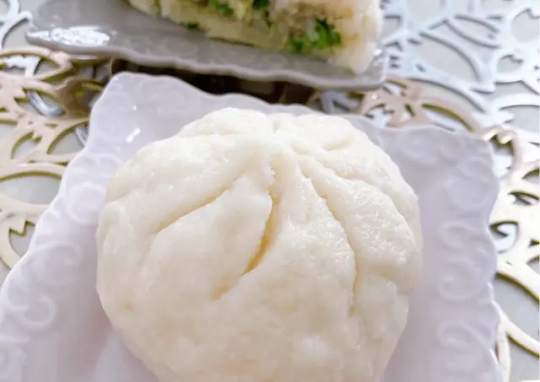
✿ 罪悪感ゼロ♪豆腐と米粉のふわもち肉まん♡ ✍️ →蒸し器,木綿豆腐
#cook:蒸す#cook:主食×主菜#cook:肉まん#cook:ひき肉#cook:豚ひき肉#cook:米粉#cook:米粉×木綿豆腐#cook:主食:米粉#cook:木綿豆腐#cook:キャベツ×たまねぎ#cook:2025〜#2025〜#cook#cook:ベーキングパウダー#cook:鶏がら#cook:ごま油×鶏がら#cook:ごま油×砂糖×塩×鶏がら#cook:ごま油×砂糖×塩×生姜×鶏がら#cook:砂糖×塩×生姜×鶏がら
0 notes
Text
In Singapore, couple are often both working so it is more convenient to just buy takeaway meals during workdays and then cook on off days. In our case, it is the reverse, mum cooks during the weekdays but not on weekends. Here, I bought Singapore Fried Noodles (星洲米粉) for her and I go for the Teriyaki Chicken & Chicken Bento as I like variety.


#Singapore Fried Noodles#星洲米粉#Rice Vermicelli#Shrimps#Char Siu#Bean Sprouts#Egg#Lime#Tze Char#煮炒#Teriyaki Chicken & Chicken Bento#Sauteed Spicy Chicken#Onions#Pickled Vegetables#Mayonnaise#White Rice#Takeaway#Packed#Dinner#Asian Food#Food#Buffetlicious
135 notes
·
View notes
Text

there’s a non-non-zero chance of success though… _(:3 」∠)_
#long depressing rant in the tags incoming ig? take warning!!#maybe it’s bc it’s 3am and i’m tired or maybe it’s bc of the 8-9 hour old fried vermicelli that i just gave up on eating but my head hurts~~#or maybe it could even be bc i spent like 3 hours unpacking my boxes (note: my fam moved last month) instead of chilling like i wanted to…#either way i saw some things while unpacking that i really should’ve left in the distant past and i’m feeling as empty as my stomach pre-米粉#though i did uncover a dogtag i had engraved years ago with nothing but a ( ͡° ͜ʖ ͡°) on it so that was pretty funny#but other than that… i remembered all the weird things i had given up on in the past via the things i unearthed…#like cooking! i unpacked this huge 1k+ page thick cookbook thing and remembered that i had a phase where i liked to cook#then i remembered that i had mistaken salt for sugar while making some meat dish with a ton of soy sauce and byebye cooking confidence :(#and to add to that i also read a past essay of mine about my culture and i remembered my grandma and i. yeah.#and i also saw stuff from my old hobbies that i had to give up on due to money/time constraints and i just. yeah.#and not to forget all the stuff from my former friends… i swear i always get ghosted the moment we affirm that we’re friends lol#am i a walking maxed social link or something? lol? yeah i have no irl friends. none.#i’ve gotten used to it though~ i don’t mind having no friends. it leaves me with more time for myself and my sleep~#it’s just that… sometimes i get the urge to hop over the country border for some ~chewing gum~ shopping… but there’s no one to go with lol#or like when i see interesting-looking events going on at local attractions but there’s no one to check it out with… or something.#and that got me wondering… am i just wasting my life or something? it’s a new year right? so i should make some lifestyle changes too right?#…and so i bought a hairdryer for the first time a few days back. yeah. that’s enough change for 1 year. lol#who needs friends when you can have a nice warm hairdryer? blast away good pal!!!!!!!!!!!!#anyways yeah. that’s my 3am rant of the day. sorry if you read this lol#sunday’s 🧂saltfest🧂#h e lp i forgot to disable rbs on this for a bit i hate 3am brain smmmm </3
9 notes
·
View notes
Photo
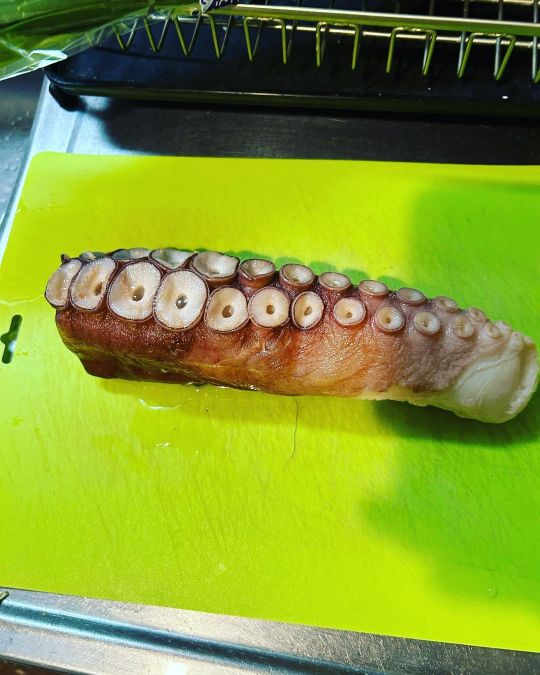
米粉たこ焼きデスティニー #たこ焼き #料理 #米粉 #takoyaki #ricepowder #cooking #cookingram #foodstagram #octopus https://www.instagram.com/p/CpmAbWWSN76/?igshid=NGJjMDIxMWI=
0 notes
Text
The Todorokis and food - Part 1: Kuzumochi (葛餅)
While working to a better, single version of my Todoroki mansion posts, I was tempted to add to it the foods we also know the Todorokis eat or the ones we see prepared in the house.
In hindsight though, it felt silly as foods aren't really neither architectonicals elements or furniture so I decided to make a separate post for them. As I work on the comprehensive version I decided to split the demo version in small parts so that people could enjoy it as it gets worked over.
This is the first bit, dealing with Enji's fave food.
ENJI’S FAVORITE FOOD: Kuzumochi (葛餅) and all that’s connected to it
In the manga we never see Enji eating it, the fact it's his favorite food is an info we learn from his profile.

However in "Ultra Impact", one of the video games, he comments about receiving Kuzumochi as a gift from a long established store that many people in his agency go at.

We also have a mention of it in "School Briefs 3" where, in the bonus fantasy story "U.A. Quest", Endeavor is described as the lonrd of the land and owner of a "kuzumochi fruit tree" and is so obsessed with it that has caused the family to break apart, driving his wife away and would want his guards to execute whoever were to try to eat the fruits of his tree. Shōto, as his heir, is supposed to keep the tree growing, but as he hates his father, refuses to so do.
Mochi (もち or 餅): a Japanese rice cake made of ‘mochigome’ (もち米), a short-grain japonica glutinous rice, and sometimes other ingredients such as water, sugar, and cornflour. The steamed rice is pounded into paste and molded into the desired shape. The shape of mochi varies depending on the region, so it can be round (west Japan) or square (east Japan). There are also various variants that slightly change the ingredients with which its done. In Japan, it is traditionally made in a ceremony called ‘mochitsuki’ (餅搗き).



While eaten year-round, mochi is a traditional food for the Japanese New Year, and is commonly sold and eaten during that time, also in form of ‘zōni’ (雑煮), a Japanese mochi soup...

...or as a ‘kagami mochi’ (鏡餅 "mirror rice cake"), made by two round mochi, the smaller placed atop the larger, and a ‘daidai’ (橙), a Japanese bitter orange with an attached leaf on top, which is first used as a traditional Japanese New Year decoration and then eaten on the second Saturday or Sunday of January.


Kuzumochi (葛餅): a transparent, pulpy ‘mochi’ (もち or 餅) made of ‘kuzuko’ (葛粉), which is the flour derived from the root of the ‘kuzu’ (クズ), instead than of cornflour. It is usually served chilled (which increases its elasticity), cut in bite-size slices which are topped with ‘kuromitsu’ (黒蜜 “black honey”) first and then ‘kinako’ (黄粉 or きなこ “yellow flour”), otherwise they won’t mix and eaten with chopsticks. If eaten freshly made while it’s slightly warm inside, one can enjoy its chewy and fluffy texture. The usual preparation consists in combining the flour with water and sugar, and cooking it over a gentle heat, stirring continuously until the mixture thickens and becomes transparent. This process also imparts it an elastic texture. The transparent appearance of the final product contributes to a cool sensation, making it a popular choice for consumption during warmer months. This is Enji’s favorite food.

Japan has however another sweet with the same name but written with different kanji (久寿餅) which is a mochi cake made from Lactobacillales-fermented ‘komugiko’ (小麦粉 “wheat flour”), and is not transparent but more like milky white. It is specialty dish local to certain wards of Tokyo.

Kuzuko (葛粉): flour derived from the ‘kuzu no ne’ (クズの根), the root of the ‘kuzu’ (クズ), a group of climbing, coiling, and trailing deciduous perennial vines native to much of East Asia better known as Kudzu or Japanese arrowroot. It’s worth to mention most products sold as ‘kuzuko’ are mixed with flour from other sources (potato, sweet potato, cornflour, etc.).

Komugiko (小麦粉 “wheat flour”): wheat flour made by milling wheat and is used as an ingredient in various foods which in Japan is also called ‘udonko’ (うどん粉 “udon flour”) or ‘MERIKEN ko’ (メリケン粉 “American flour”).

Kuromitsu (黒蜜 "black honey"): a Japanese sugar syrup, similar to molasses, but thinner and milder and is a central ingredient in many Japanese sweets, among which ‘kuzumochi’ (葛餅).

Kinako (黄粉 or きなこ "yellow flour"): roasted soybean flour, used in Japanese cuisine, better known in English speaking countries as "roasted soy flour". Kinako is mostly used as a topping to flavor rice cakes like ‘mochi’ (もち or 餅).

Kuzumochi (葛餅) recipe
Ingredients:
40g kuzuko (arrowroot flour)
200ml lukewarm water
1½ tablespoons granulated sugar (optional)
Kuromitsu (Brown Sugar Syrup)
Kinako (Roasted Soybean Flour)
Instructions:
In a small bowl whisk the Kuzuko into the water until all lumps are removed (some also add 1½ tablespoons granulated sugar to the mix). Use a whisk or rubber spatula to dissolve the starch completely. It starts out as an opaque white liquid.
To make sure there are no more lumps, strain it to a sieve before pouring it in a small saucepan.
Heat over medium heat stirring with a wooden spoon until the mixture thickens and becomes white (it usually takes 3-4 minutes).
Turn the heat down to low and cook for a few more minutes continuing to stir the ingredients in the pot to make them homogeneous, until the mixture becomes translucent and bubbly.
Afterward place it in a container that will work as a mold to give it its shape.
At this point you can:
let cook for 30 minutes to room temperature
immerse the bottom of the containers in cold water
immerse the bottom of the containers in cold water to which ice was added.
The last two options allow the kuzumochi to harden faster.
You can serve the kuzumochi while it is still soft, or even put it in the refrigerator for 1-2 hours to further harden and cool.
Serve it cut in slices, cover it in Kuromitsu and only after add the Kinako so as to insure the two will mix well.
NEXT: TŌYA AND SHŌTO’S FAVORITE FOOD: soba (蕎麦) and all that’s connected to it
6 notes
·
View notes
